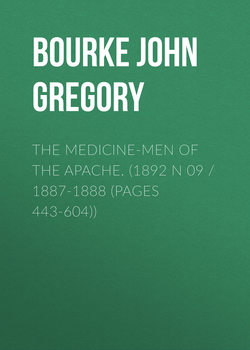Читать книгу The Medicine-Men of the Apache. (1892 N 09 / 1887-1888 (pages 443-604)) - Bourke John Gregory - Страница 8
CHAPTER I
THE MEDICINE-MEN, THEIR MODES OF TREATING DISEASE, THEIR SUPERSTITIONS, PARAPHERNALIA, ETC
THE CROSS
ОглавлениеThe sign of the cross appears in many places in Apache symbolism. The general subject of the connection of the cross with the religion of the aborigines of the American continent has been so fully traversed by previous authors that I do not care to add much more to the subject beyond saying that my own observation has assured me that it is related to the cardinal points and the four winds, and is painted by warriors upon their moccasins upon going into a strange district in the hope of keeping them from getting on a wrong trail.
In October, 1884, I saw a procession of Apache men and women, led by the medicine-men bearing two crosses, made as follows: The vertical arm was 4 feet 10 inches long, and the transverse between 10 and 12 inches, and each was made of slats about 1½ inches wide, which looked as if they had been long in use. They were decorated with blue polka dots upon the unpainted surface. A blue snake meandered down the longer arm. There was a circle of small willow twigs at top; next below that, a small zinc-cased mirror, a bell, and eagle feathers. Nosey, the Apache whom I induced to bring it to me after the ceremony, said that they carried it in honor of Guzanutli to induce her to send rain, at that time much needed for their crops. It is quite likely that this particular case represents a composite idea; that the original beliefs of the Apache have been modified to some extent by the crude ideas of the Mexican captives among them, who still remember much that was taught them in the churches of the hamlets in northern Mexico, from which they were kidnapped years ago; but, on the other hand, it is to be remembered that the cross has always formed a part of the Apache symbolism; that the snake does not belong to the Christian faith, and that it has never been allowed to appear upon the cross since the time of the Gnostics in the second and third centuries. Therefore, we must regard that as a Pagan symbol, and so must we regard the circle of willow twigs, which is exactly the same as the circle we have seen attached to the sacred cords for the cure of headache.125
The cross was found in full vogue as a religious emblem among the aborigines all over America. Father Le Clercq126 speaks of its very general employment by the Gaspesians: "Ils ont parmi eux, tout infideles qu'ils soient, la Croix en singuliere veneration, qu'ils la portent figurée sur leurs habits & sur leur chair; qu'ils la tiennent à la main dans tous leurs voïages, soit par mer, soit par terre; & qu'enfin ils la posent au dehors & au dedans de leurs Cabannes, comme la marque d'honneur qui les distingue des autres Nations du Canada." He narrates127 that the Gaspé tradition or myth was, that the whole tribe being ravaged by a plague, the medicine-men had recourse to the Sun, who ordered them to make use of the cross in every extremity.
Herrera relates that the followers of Hernandez de Cordoba found at Cape Catoche "unos Adoratorios … i Cruces pintadas que les causò gran admiracion."128 He also says that Juan de Grijalva on the island of Cozumel found a number of oratories and temples, but one in particular was made in the form of a square tower, with four openings. Inside this tower was a cross made of lime, which the natives reverenced as the god of the rain; "una Cruz de Cal, de tres varas en alto, à la qual tenian por el Dios de la lluvia."129
125
"When the rain-maker of the Lenni Lennape would exert his power, he retired to some secluded spot and drew upon the earth the figure of a cross (its arms toward the cardinal points?), placed upon it a piece of tobacco, a gourd, a bit of some red stuff, and commenced to cry aloud to the spirits of the rains." – Brinton, Myths of the New World, New York, 1868, p. 96 (after Loskiel).
126
Père Chrestien Le Clercq, Gaspesie, Paris, 1691, p. 170.
127
Ibid., cap. x, pp. 172-199.
128
Dec. 2, lib. 2, p. 48.
129
Ibid., p. 59.
